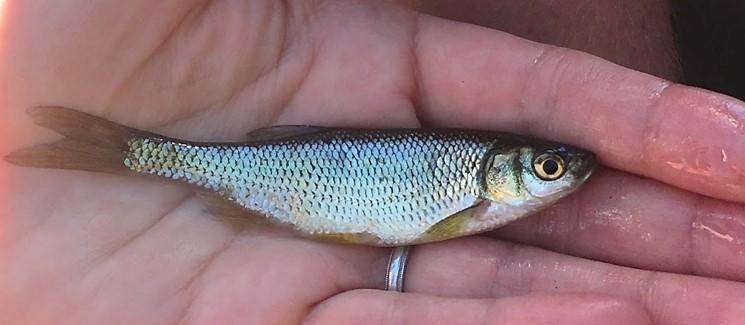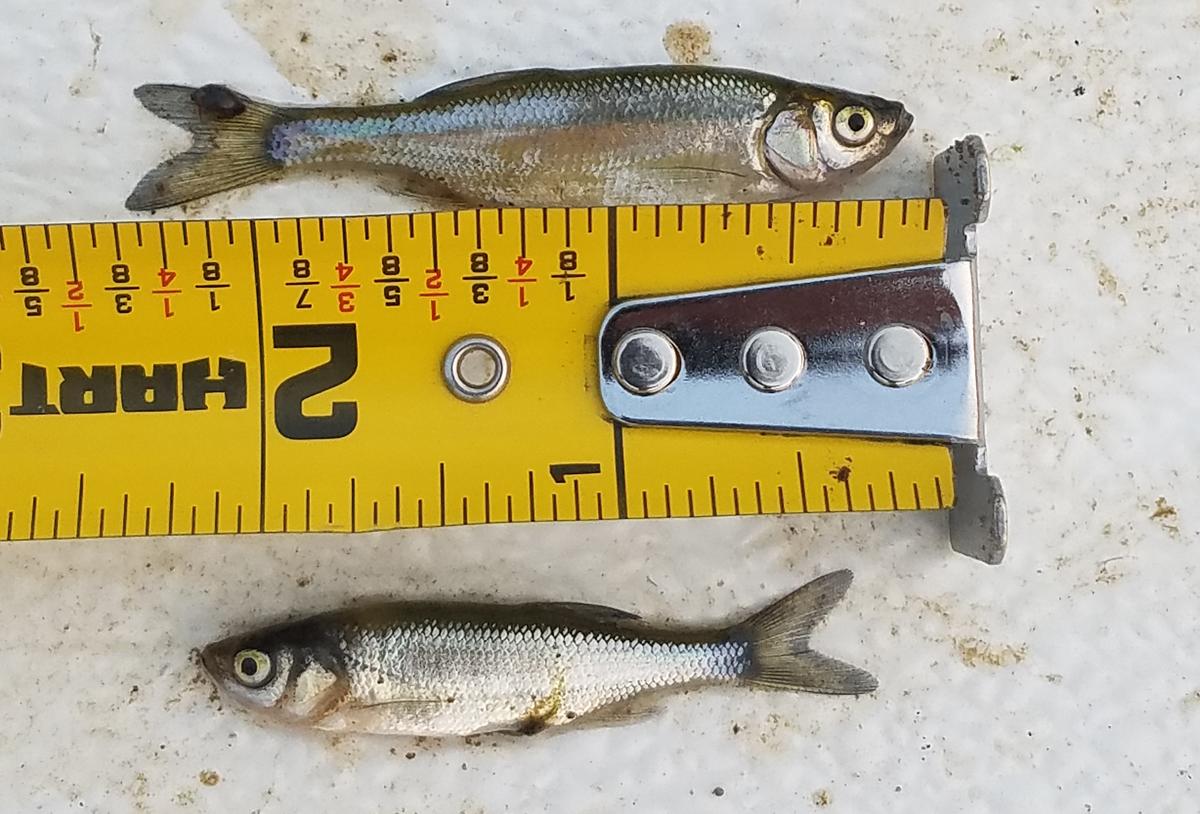What to Feed a Golden Shiner

Golden Shiner minnow in the palm of a person's hand. Image credit: Amy Schrank.
The University of Minnesota Sea Grant program and partners are investigating new strategies for producing Golden Shiner fish for Minnesota's bait industry. The project is supported by a three-year $188,000 grant from the Legislative-Citizen Commission on Minnesota Resources .

Image credit: Barry Thoele
"This project not only aims to increase the supply of locally grown Golden Shiner for anglers, but also seeks to grow these valuable fish in the budding aquaculture and aquaponics (growing fish and plants together) businesses" said Amy Schrank, MNSG fisheries and aquaculture extension educator and project lead.
Expand all
What are Golden Shiners and why are they important?
The G olden Shiner ( Notemigonus crysoleucas ) is a minnow in the cyprinid family that is native to eastern North America.
In Minnesota, demand for Golden Shiners (Notemigonus crysoleucas) used as bait exceeds in-state production. Recent projections by bait dealers estimate a deficit of approximately 10,000 gallons of Golden Shiner annually. There is pressure from anglers, bait dealers, and legislators to import them from other states. However, importation can introduce aquatic invasive species such as invasive carps and fish diseases, which can negatively impact state waters and jeopardize valuable native fish species. Golden Shiners are also an excellent candidate for indoor production because they are a hardy fish, spawn multiple times a year, and their spawning times can be manipulated by adjusting water temperature and lighting conditions.
Project description
Why Are Golden Shiners Important?
In Minnesota, demand for Golden Shiners (Notemigonus crysoleucas) used as bait exceeds in-state production. Recent projections by bait dealers estimate a deficit of approximately 10,000 gallons of Golden Shiner annually. There is pressure from anglers, bait dealers, and legislators to import them from other states. However, importation can introduce aquatic invasive species such as invasive carps and fish diseases, which can negatively impact state waters and jeopardize valuable native fish species. Golden Shiners are also an excellent candidate for indoor production because they are a hardy fish, spawn multiple times a year, and their spawning times can be manipulated by adjusting water temperature and lighting conditions.
The goal of the project is to increase production of Golden Shiner for bait in Minnesota. The objectives of the project are to (1) identify and demonstrate the best methods for in-state production of Golden Shiner and (2) communicate findings and recommendations to commercial bait producers by publishing a project report, a production (how-to) manual, and holding three workshops to transfer results of this project. Published materials will be made available through this website.
The project started during the Fall of 2021 and will be completed by June 30, 2024.
What Are The Project Strategies?
The project team will demonstrate and evaluate the following four strategies that could increase in-state production of Golden Shiner:
- Intensive rearing of Golden Shiner, all indoors, using a recirculating aquaculture system (RAS).
- Using Golden Shiner in an aquaponics (plants + fish) system, similar to RAS, but with the added benefit of growing plants.
- Growing Golden Shiner by stocking constructed dug ponds with newly hatched sac-fry (~1/4 inches) in May and harvesting in October.
- Producing feed-trained Golden Shiner indoors to a size of 1-2 inches, then stocking them into constructed ponds in May to grow out with the anticipation of harvesting market sized fish in October.
Benefits of Indoor Production?
Producing Golden Shiner bait fish in indoor facilities, entirely or partially, extends their growing period, which enables them to reach marketable size in 9 months or less. Indoor production also avoids the high mortality and slow growth that result from overwintering Golden Shiners in natural outdoor ponds.
Why Minnesota Sea Grant?
MNSG staff were asked to assist with the planning and implementation of the Golden Shiner project by members of the bait industry and the Minnesota Department of Natural Resources. The skills and expertise of MNSG fisheries and aquaculture staff ensure that they are well positioned to coordinate the project and address stakeholders concerns while also protecting Minnesota's natural resources.
What have we done lately?
2022
- The project team continues to meet monthly to coordinate and plan activities.
- Golden Shiner broodstock were collected from natural ponds and moved to the hatchery where successful spawning has been taking place.
- Successful feed training of sac-fry has occurred (using rotifers and then commercial dry food) and experimentation to find the most effective commercial feed is taking place.
- The hatchery is preparing to supply sac-fry and feed trained fry needed for transfer to constructed grow-out ponds.
- Ponds have been selected for stocking and summer grow-out.
- Equipment to monitor water quality has been installed.
- Data collection and monitoring protocols have been initiated.
Participants & audience
The MNSG Golden Shiner project seeks to serve the bait industry, aquaculture and aquaponics producers and anglers in Minnesota and the Great Lakes Region.
Project collaborators include Barry Thoele, owner of Lincoln Bait and Barry's Cherries Hydroponic Produce; Marc Tye, owner of Tye Fish Solutions; Tonny Vang, owner of Happy Fish Aquaponics; and the Minnesota Department of Natural Resources , Section of Fisheries.
Funding
MNSG's Golden Shiner project is funded by a $188,000 Legislative-Citizen Commission on Minnesota Resources (LCCMR) grant from the Environment and Natural Resources Trust Fund that was awarded in the fall of 2021.
Funding for this project was provided by the Minnesota Environment and Natural Resources Trust Fund as recommended by the Legislative-Citizen Commission on Minnesota Resources (LCCMR). The Trust Fund is a permanent fund constitutionally established by the citizens of Minnesota to assist in the protection, conservation, preservation, and enhancement of the state's air, water, land, fish, wildlife, and other natural resources.
rexroadafteptips64.blogspot.com
Source: https://seagrant.umn.edu/programs/fisheries-and-aquaculture-program/producing-golden-shiner-bait
Belum ada Komentar untuk "What to Feed a Golden Shiner"
Posting Komentar